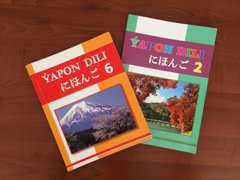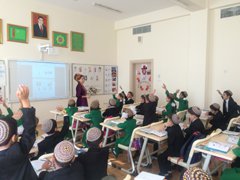Japanese-Language Education in Turkmenistan
Dovletmammet Azadi Turkmen National Institute of World Languages / National Institute of Education of Turkmenistan
SATO Goro
Do you have any idea where the nation of Turkmenistan is located? Have you ever even heard the name “Turkmenistan?” When I told the people around me that I was to be dispatched to Turkmenistan, almost everyone reacted by saying, “What, do you mean Turkey?” I therefore must admit that there is very little awareness of Turkmenistan in Japan.
However, even in this country located in virtually the center of the Eurasian continent, a country that takes more than 30 hours to reach from Japan, there are people who are learning the Japanese language. Not only are there people, there are over 3,000 people, the largest number of learners in Central Asia.
Launching and Expanding Japanese-Language Education
Japanese-language education began in Turkmenistan in 2007. In the same year, the current President Gurbanguly Berdimuhamedov took office as the 2nd president of the country, and a Japanese-language major was established at the Faculty of Oriental Languages and Literatures of the Dovletmammet Azadi Turkmen National Institute of World Languages (hereinafter “Azadi University”). Since that time, a span of roughly ten years, Azadi University has remained the only Japanese-language educational institution in the country.
However, a major change occurred in October 2015. Prompted by the visit by Prime Minister Shinzo Abe to Turkmenistan, President Berdimuhamedov made the decision to commence Japanese-language education at other institutions of higher educational institutions in addition to Azadi University, as well as at some primary and secondary schools.
Accordingly, Japanese-language education began expanding in the country rapidly from the following September 2016. As of 2018, Japanese is now offered at six universities, ten secondary schools, and one primary school, and there are now about 3,400 learners and 30 teachers. Prior to 2015, there was only one institution, about 50 learners, and four or five teachers, so the speed at which the expansion occurred is remarkable.
Broken down by educational level, the largest number of students is found at the secondary school level (equivalent to grade 5 of elementary school through grade 3 of high school in Japan) with approximately 2,000 students. This is followed by approximately 1,000 students at the higher education level, and approximately 360 at the primary school level (equivalent to grades 1 through 4 of elementary school in Japan). Furthermore, that number increases by roughly 1,000 students each year because the number of learners at primary and secondary educational institutions increases by one grade each year.
Problems Facing Japanese-Language Education and the Job of the Japanese-Language Specialist
While the increase in the number of learners is of course something to be happy about, it is also causing some challenging problems as well.
The most serious among them is the shortage of teachers. To date, 60 students majoring in Japanese have graduated from Azadi University, and if there is no educational institution teaching Japanese in the region they live in, they end up having to take a job in some other line of work, such as teaching English. Accordingly, less than thirty are currently working as Japanese-language teachers. The shortage is most serious at the level of primary and secondary education, and there are some schools where a single teacher must instruct over 400 students.
Furthermore, the majority of those teachers have never learned Japanese-language teaching methods, so they must lead their classes through trial and error as they try to remember what it was like for them as students. The majority of classes in Turkmenistan consist of rote learning, and I get the sense that most of the teachers follow a standard pattern of explaining the grammar, having the students translate example texts in the teaching materials from Japanese into Turkmen, and subsequently deeming them to have understood.

Japanese teaching materials for primary and secondary students
The Japan Foundation has dispatched one Japanese-Language Senior Specialist (hereinafter “Senior Specialist”) and one Japanese-Language Assistant to the country since September 2016, and the Senior Specialist in particular must provide a variety of support for each level of education. Specifically, this includes the following tasks: the creation of Japanese-language teaching materials for primary and secondary schools, training for existing teachers, advising via school visits and class observation, advice on the curriculum and classes at Azadi University, holding workshops for the Turkmen teachers at Azadi University to improve their knowledge and skill at Japanese and teaching Japanese, and teaching classes at Azadi University, mainly on teaching methodologies.

A fifth-grade class.
Each of those tasks is important, and it is hard to set priorities, but there can be no class without a textbook, so I put particular effort into that. As I work on the teaching materials, I consider the developmental stage of the students and the relationship of Japanese to other subjects, and try to incorporate activities that make full use of their thinking ability, imagination, and creativity. Another aim is to ensure that the teaching materials are easy to use for teachers who are inundated with classes and are unable to find the time to study the teaching materials. Ideally, my hope is that even if the teachers simply follow the teaching materials to the letter, the result will be active, interactive, and communicative classes. I have had numerous opportunities to test my teaching materials at schools in Ashgabat. Every day as I work, I recall the smiling faces of those children, and try to think of ways to bring out those smiles even more. I would have no greater joy than to know that those children came to see Japanese class as fun.
At only 27 years since its founding, Turkmenistan is still a young country. And there is great potential in this country for Japanese-language education, which itself has only just begun. As I continue with my work, I feel the good fortune and responsibility of being involved in Japanese-language education in Turkmenistan.
- What We Do Top
- Arts and Cultural Exchange [Culture]
- Japanese-Language Education Overseas [Language]
- Japanese-Language Education Overseas [Language] Top
- Learn Japanese-language
- Teach Japanese-language
- Take Japanese-Language Test
- Know about Japanese-language education abroad
- The Japanese-Language Institute, Urawa
- The Japanese-Language Institute, Kansai
- Japanese-Language Programs for Foreign Specified Skilled Worker Candidates
- Japanese Language Education for Japanese Children Resident Overseas and for the Descendants of Migrants
- Archives
- Japanese Studies and Global Partnerships [Dialogue]
- JF digital collection
- Other Programs / Programs to Commemorate Exchange Year
- Awards and Prizes
- Publications
